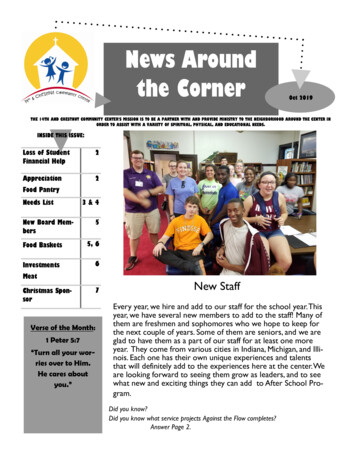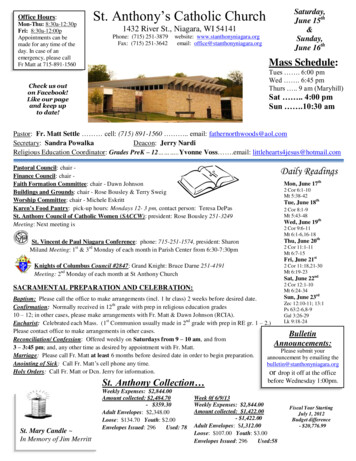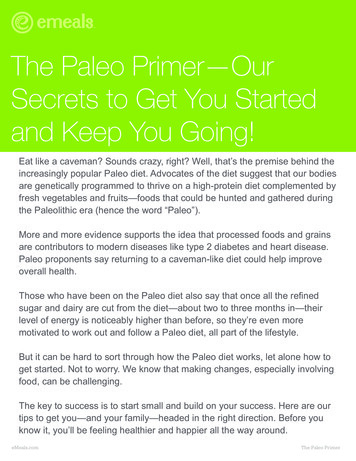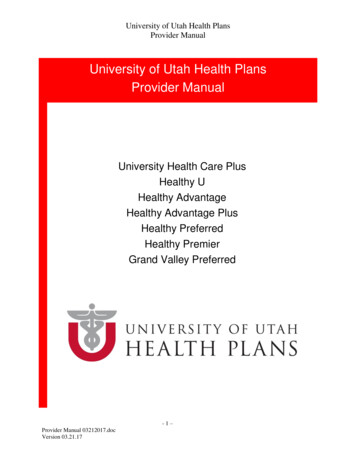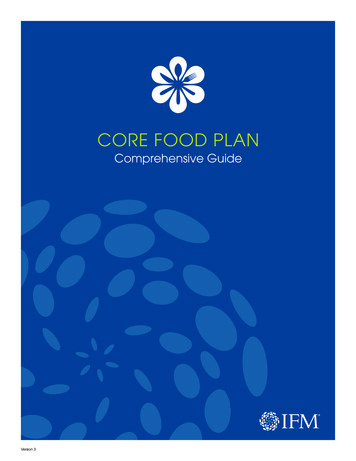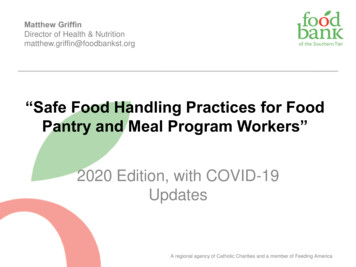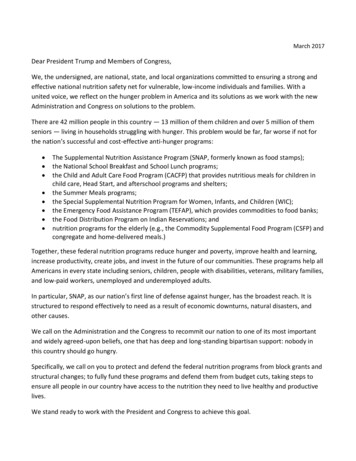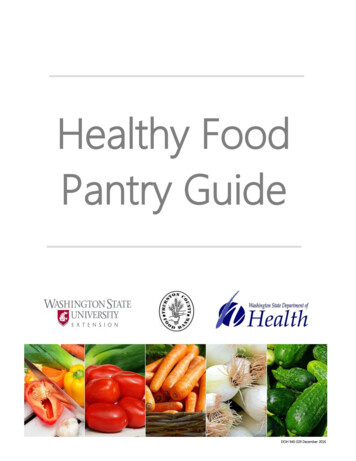
Transcription
Healthy FoodPantry GuidePage 1DOH 940-029 December 2016
Table of ContentsAcknowledgements . 3About . 4Food Pantry Self-Assessment . 5Client Services . 71. Encourage Client Choice. 82. Meet Language and Culture Needs . 93. “No Questions Asked” Self-Service . 104. Link Clients to Related Services . 11Health Promotion . 121. Nutrition Education Programs. 132. Market Healthy Options . 143. Fruit and Vegetable Voucher Programs . 154. Meet Special Diet Needs . 16Securing Food. 171. Request Specific Foods . 182. Garden Programs . 193. Collect Gleaned and Leftover Produce. 204. Purchase in Bulk . 215. Track Nutrient Dense Foods . 22Capacity Development . 231. Strong Volunteer Force . 242. Staff and Volunteer Training . 253. Share Healthy Pantry Successes . 264. New Funding for Capacity . 275. Maintain Policies and Procedures . 28Partnership Building . 291. Attend School and Community Events. 302. Anti-Hunger Coalitions . 313. Meet with Health Care Partners . 324. Bring Together Farms and Pantries . 33For persons with disabilities, this document is available on request in other formats. To submit arequest, please call 1-800-525-0127 (TDD/TTY 711).
AcknowledgementsThis document is the result of 2-year collaboration between SNAP-Ed agencies and anti-hungerleaders listed below: Thurston County Food Bank, Olympia, WA Washington State University – Extension, SNAP-Ed Program Washington State Department of Health, SNAP-Ed Program Washington State Department of Agriculture (WSDA), Food Assistance and Regional MarketsThis document builds on and supports foundational work of many anti-hunger advocates andstakeholders in Washington, including and not limited to: Washington Food Coalition (WFC) Food Lifeline (FL) Northwest Harvest (NWH)The food pantry self-assessment was adapted from the University of Wisconsin Extension Safe &Healthy Food Pantries Project: Canto, A., B. Ingham, and S. Larson. (2015). Safe & Healthy Food Pantries Project. Madison:University of Wisconsin-Extension.Page 3
AboutThe Healthy Food Pantry Guide provides strategies to create a healthy food pantry. It also offerssuggestions for how Supplemental Nutrition Assistance Program Education (SNAP-Ed) maycontribute to these efforts while staying within SNAP-Ed program guidelines. While this guide isintended for use by SNAP-Ed managers and their local food pantry partners, it may also be of use tofood pantries not receiving SNAP-Ed.The Healthy Food Pantry Guide also includes a self-assessment for food pantries. The selfassessment corresponds with the healthy food pantry strategies described in pages 7-33. The selfassessment is an opportunity for SNAP-Ed managers and food pantry partners to assess how theircurrent efforts to build a healthy food pantry align with the strategies included in this guide. It’s alsoa shortcut to finding out what strategies might be of most interest or importance to the foodpantry.The strategies within this guide reflect the current Dietary Guidelines for Americans (DGA) includingthe use of MyPlate. Although food insecurity limits a household’s ability to acquire adequate food tomeet their nutritional needs, a food pantry filled with a variety of nutritious foods supports makingthe healthy choice the easy choice for food pantry clients.MyPlate reminds people to find their healthy eating style and buildit throughout their lifetime. This means: Focus on variety, amount, and nutrition Choose foods and beverages with less saturated fat, sodium,and added sugars Start with small changes to build healthier eating styles Support healthy eating for everyoneSee more at choosemyplate.gov.This document is not a complete reference. We will make regular updates. Your feedback andcomments will help us make this guide better. For more information about the Healthy Food PantryGuide, email SNAP-Ed@doh.wa.gov.Page 4
WASHINGTON FOOD PANTRYSELF-ASSESSMENT IN PARTNERSHIP WITH WASHINGTON SNAP-EDSNAP-Ed Partner:Name of Pantry:Address of Pantry:County:StreetRespondent:Respondent position:Date:CityStateZip CodePhone:E-mail:IN PLACESTRATEGYNOTO SOMEEXTENTYESCLIENT SERVICESCS-1Arrange pantry in a “shopping” style to encourageclient choice CS-2Meet language and culture needs (translatedmaterials, cultural foods, etc.) CS-3Make available “No Questions Asked” self-servefood CS-4Link clients to related services (WIC, TANF, etc.) HEALTH PROMOTIONHP-1Offer nutrition education programming HP-2Market and promote healthy options within thefood pantry HP-3Coordinate fruit and vegetable vouchers or “giftcertificates” with community partners HP-4Meet special diet needs (gluten free, low sodium,non-dairy, etc.) and highlight nutrition guidance SECURE FOODSSF-1Request specific food (healthy options) for fooddrives SF-2Establish a pantry garden or collect gardendonations SF-3Collect gleaned and leftover produce from farmsor farmers markets SF-4Purchase fresh and frozen fruits and vegetablesin larger amounts to lower their price SF-5Track nutrient dense foods through an inventorysystem like “CHOP” or “Foods 2 Encourage” This assessment was adapted from the University of Wisconsin Extension Safe & Healthy Food Pantries Project.Page 5
WASHINGTON FOOD PANTRYSELF-ASSESSMENT IN PARTNERSHIP WITH WASHINGTON SNAP-EDIN PLACESTRATEGYNOTO SOMEEXTENTYESCAPACITY DEVELOPMENTCD-1Recruit a strong and diverse volunteer force CD-2Enhance staff and volunteer training andprofessional development CD-3Share or promote healthy strategies in place atthe food pantry CD-4Identify new sources of funding through funddrives or grants CD-5Maintain an operational policies and proceduresmanual PARTNERSHIP BUILDINGPB-1Attend school family nights and other communityevents PB-2Participate in anti-hunger coalitions PB-3Meet with health care partners to addressobesity-related chronic disease in community PB-4Bring together farms and pantries PERCENT (%)OF TOTALFOODINVENTORYLEVEL OF CONTROLNOCONTROLSOMECONTROLA LOT OFCONTROLTEFAP (USDA commodities) EFAP (WSDA financial assistance) Food distributors (NW Harvest,Food Lifeline, 2nd Harvest, etc.) Community donation or food drives Commercial donors Other sources: (please specify) SOURCETotal100%This assessment was adapted from the University of Wisconsin Extension Safe & Healthy Food Pantries Project.Page 6
Client Services(CS)Our pantry identifiesand meets the needsof clients whendistributing food.Page 7
CS-1 Encourage Client ChoiceOur pantry is set-up like a grocery store. We encourageclients to “shop” to find the foods they need.Benefits Clients are less likely to throw out food.Clients try new foods.Things a Pantry Can DoCreate or enhance client choice/shopping style in the pantry.Make signs or displays like a grocery store or farmers market.Encourage clients to ask questions.Client Services SNAP-Ed Can Help Answer your questions about how to encourage client choice.Provide signs/displays.ResourcesReal-Life ExamplesOther ResourcesWFC Best PracticesTri-Cities Food Bankagr.wa.gov/FoodProg/docs/Best Practices Manual.pdfChoice Pantry Guideohiofoodbanks.orgPromoting Client Choicehungercenter.orgPage 8
CS-2 Meet Language and Culture NeedsOur pantry works with the community to welcomedifferent languages and cultures.Benefits Clients are more satisfied.Improved customer service.Improved client health and food security.Pantry may be eligible for new grant funding.Things a Pantry Can DoConduct an assessment with the community to identify gaps.Offer intake forms, marketing materials, and signs in languages clients can read.Request culturally appropriate foods for donation.Incorporate cultural foods into lesson plans and cooking demonstrations.Find volunteers who represent the community.Train volunteers how to meet language and culture needs.Get civil rights training—civil rights training is required by many grants.Client Services SNAP-Ed Can Help Give advice on how to do an assessment.Provide lessons and marketing materials in different languages.Assist with donor education about culturally appropriate foods.Include cultural foods in lesson plans and cooking demonstrations.ResourcesReal-Life ExamplesOther ResourcesWFC Best PracticesAsian Counseling and Referral ServiceLifelong Aids AllianceWalla Walla Salvation Armyagr.wa.gov/FoodProg/docs/Best Practices Manual.pdfUSDA Recipe Finderwhatscooking.fns.usda.govCivil Rights Training Videojustice.govPage 9
CS-3 “No Questions Asked” Self-ServiceOur pantry provides some foods to clients in a hungeremergency without requiring proof of need.Benefits Increase food security.Prevent food waste.Build trusting relationships between clients and food pantry.Things a Pantry Can DoPlace food near the entrance/exit, or in a shared lobby.Have a volunteer available to help distribute food and answer questions.Client Services SNAP-Ed Can Help Offer advice on the healthiest choices.Offer advice on food safety.ResourcesReal-Life ExamplesOther ResourcesWFC Best PracticesHelpline Houseagr.wa.gov/FoodProg/docs/Best Practices Manual.pdfP a g e 10
CS- 4 Link Clients to Related ServicesOur pantry serves the same clients as other assistanceprograms. We share information about other serviceswith our food pantry clients.Benefits All of client’s needs are met.Clients have more information about services in the community.Things a Pantry Can Do Partner with programs like Women, Infants, and Children (WIC),Supplemental Nutrition Assistance Program (SNAP), and TemporaryAssistance for Needy Families (TANF) to reach new clients.Provide a place where partners can train pantry volunteers how torefer clients to their services.Client Services sNAP-Ed Can Help Share information about outreach opportunities.Introduce you to possible community partners.ResourcesReal-Life ExamplesOther ResourcesWFC Best PracticesResource Access ProjectVashon Maury Community Food Bankagr.wa.gov/FoodProg/docs/Best Practices n, Infants, and Children (WIC)doh.wa.govCommunity Youth Services (CYS)communityyouthservices.orgP a g e 11
HealthPromotion(HP)1.2.3.4.Our pantry staff andvolunteers encouragehealthy choices.Nutrition Education ProgramsMarket Healthy OptionsFruit and Vegetable Voucher ProgramsMeet Special Diet NeedsP a g e 12
HP-1 Nutrition Education ProgramsOur pantry offers food demonstrations and/or nutritioneducation classes.Benefits Clients learn about healthy foods.Clients take home more healthy foods.Clients learn about planning budgets, planning meals, and food safety.Things a Pantry Can Do Assess space and available cooking equipment.Offer space to programs that do nutrition education.Offer samples of available foods. Health PromotionSNAP-Ed Can HelpConduct food demonstrations that use foods available at the pantry.Provide tips and answer questions.Provide nutrition education based on pantry and client needs (Examples:healthy eating on a budget, menu planning, use of commodity foods,cooking skills, and growing your own foods).Design and display healthy food and food safety materials.ResourcesReal-Life ExamplesOther ResourcesWFC Best PracticesCare and Share Food Bankagr.wa.gov/FoodProg/docs/Best Practices Manual.pdfDOH SNAP-Eddoh.wa.govFood ensenutrition.wsu.eduJust Say Yes to Fruits and Veggiesjsyfruitveggies.orgP a g e 13
HP-2 Market Healthy OptionsOur staff and volunteers know how and where to placehealthy items so clients select them.Benefits Maintains Client Choice (CS-1).Clients are more satisfied.Clients are familiar with new foods.Less food is wasted.Things a Pantry Can Do Make vegetables and fruit more attractive by taking away spoileditems and removing wilted and dirty leaves.Display fresh fruits and vegetables where easy to see and reach.Place fresh fruits and vegetables at the front of shopping area.Post information by food items showing how to cut up, prepare, andstore.Promote healthy items with bulletin boards, posters, and videos.Hand out recipe cards.Volunteers and/or staff can encourage healthy choices by explaininghow to use the foods.Health Promotion SNAP-Ed Can Help Assess, place, and test item placement to determine what works best.Provide recipe cards and food preparation cards.Train staff and volunteers on how to market healthy options.ResourcesReal-Life ExamplesOther ResourcesYou could be listed here!Nudgesfeedingamerica.orgP a g e 14
HP-3 Fruit and Vegetable Voucher ProgramsOur pantry provides or promotes fruit and vegetablevouchers for clients to use at local stores and farmersmarkets.Benefits Reduced cost fruits and vegetables.Clients eat more fruits and vegetables.Increased support for local food system.Things a Pantry Can DoTalk to partners about voucher/incentive programs in our community.(Example: SNAP-Ed programs, farmers markets, food advocates)Health Promotion SNAP-Ed Can Help Connect food pantries to voucher programs.Give advice about other funding.Promote voucher programs with low-income clients.ResourcesReal-Life ExamplesOther ResourcesWFC Best PracticesUniversity District Food Bankagr.wa.gov/FoodProg/docs/Best Practices Manual.pdfFind a Farmers Marketwafarmersmarkets.comFresh Bucksfreshbucks.orgComplete Eatsdoh.wa.govP a g e 15
HP-4 Meet Special Diet NeedsOur pantry provides an area with food and resources forclients with special diet needs.Benefits More choices for clients with special diet needs.Demonstrate commitment to client health.Things a Pantry Can Do Promote healthy options for all clients (e.g., low-sodium, low-sugar,higher nutrient content, and fewer ingredients).Have an area with food and resources for people with special diets.Connect with other organizations in the community that help peoplewith special diets.Write a policy to label foods for people on special diets.Health Promotion SNAP-Ed Can Help Provide nutrition education materials about healthy options.Assist with developing a labeling policy and process.ResourcesReal-Life ExamplesOther ResourcesWFC Best PracticesLifelong Aids Allianceagr.wa.gov/FoodProg/docs/Best Practices Manual.pdfSpecial Dietary Needs: Information & Tools ForHunger Relief Agencies To Meet The Needs OfEvery Dietagr.wa.gov/FoodProg/docs/Special Dietary Needs.pdfP a g e 16
SecuringFood (SF)1.2.3.4.5.Our pantry seekshealthier foodoptions.Request Specific FoodsGarden ProgramsCollect Gleaned and Leftover ProducePurchase in BulkTrack Nutrient Dense FoodsP a g e 17
SF-1 Request Specific FoodsOur pantry requests specific foods during food drives toprovide a “MyPlate” selection to clients.Benefits Pantry’s stock of food is balanced.Demonstrate commitment to client health.Things a Pantry Can Do Create a list of needed foods based on current and anticipatedstock.Share list of needed foods with food drive organizers.Post list of needed foods on pantry website.Look at what other foods will be entering the distribution systemfrom other sources (EFAP, TEFAP, Food Lifeline, 2nd Harvest, etc.).Securing Food SNAP-Ed Can Help Share lists and suggestions from other pantries.Share lists with purchasing organizations.ResourcesReal-Life ExamplesOther ResourcesWFC Best PracticesHood Canal Food Bankagr.wa.gov/FoodProg/docs/Best Practices Manual.pdfHost a Food and Fund Driveoregonfoodbank.orgP a g e 18
SF-2 Garden ProgramsOur pantry uses a plot of land for a food garden or has agarden bounty program that collects garden producefrom the community.Benefits More produce available to clients.New volunteers.Use a garden as a learning lab or outdoor classroom.Things a Pantry Can Do Borrow land nearby, especially within sight of the food bank line.Rally volunteers and clients to be in charge of garden.Work with local media like radio stations and newspapers topromote donating excess garden produce.Speak with WSDA about ways to use EFAP dollars for a food gardenor bounty program.Securing Food SNAP-Ed Can Help Support staffing for the garden program.Support the purchase of seeds, soil, educational supplies.Provide garden-enhanced nutrition education.ResourcesReal-Life ExamplesOther ResourcesWFC Best PracticesEmergency Food NetworkMarysville Community Food BankSolid Groundagr.wa.gov/FoodProg/docs/Best Practices Manual.pdfP-Patch Community Gardensseattle.govPlant-a-Rowgardenwriters.orgWSU Extension Master Gardenersmastergardener.wsu.edu/program/countyP a g e 19
SF-3 Collect Gleaned and Leftover ProduceOur pantry collects unwanted or donated produce fromfarms or farmers markets.Benefits Increased access to fruits and vegetables.Decrease food waste.New sources of support for the food pantry.Things a Pantry Can Do Ask farmers market managers to request vendors donate unsoldproduce.Organize volunteers or food bank staff to collect unharvested producefrom local farmers.Speak with WSDA about its small farm direct purchasing program andother ways to purchase fruits and vegetables.Securing Food SNAP-Ed Can Help Introduce you to farmers markets and local farmers.ResourcesReal-Life ExamplesOther ResourcesWFC Best PracticesBroadway Farmers MarketPierce County Gleaning Projectagr.wa.gov/FoodProg/docs/Best Practices Manual.pdfWSDA Farm to Food Pantry Programfirstharvest.orgGrowing Connections: A Resource Guide forFarm-to-Food Bank Strategiesnorthwestharvest.orgU.S. Food Waste Challengeusda.govP a g e 20
SF-4 Purchase in BulkOur pantry buys fresh and frozen produce in bulk for adiscount.Benefits More produce at a lower cost.Rely less on donations.Things a Pantry Can Do Ask local food distributors if they have capacity to pass-through bulkpurchases (expect to assist in overhead to help cover some of the leadagency’s costs).Make purchases based on dry or temperature controlled capacity.Talk to WSDA about its small farm direct purchasing program and otheralternate ways to purchase fruits and vegetables.Plan ahead and look at what other foods are coming into the system fromother sources (EFAP, TEFAP, Food Lifeline, 2nd Harvest, etc.).Securing Food SNAP-Ed Can Help Refer small food pantries to WSDA for different procurementopportunities and services.ResourcesReal-Life ExamplesOther ResourcesWFC Best PracticesNorthwest HarvestSeattle Food Committeeagr.wa.gov/FoodProg/docs/Best Practices Manual.pdfFresh Fruit and Vegetable Handling Guidelinesfor Food Pantriesrutgers.eduP a g e 21
SF-5 Track Nutrient Dense FoodsWe track or inventory our pantry’s stock of healthieroptions to ensure a “MyPlate” selection for clients.Benefits The pantry’s stock of food is balanced.Show commitment to client health.Funders often require some of this information.Things a Pantry Can Do Use the Healthier Food Option Reporting (HFOR) system to build ahealthier food pantry.Look into inventory systems like “Foods to Encourage” (F2E) or“Choose Healthy Options Program” (CHOP).Work with partners to write a procurement policy that includesnutrient dense foods.Securing Food SNAP-Ed Can Help Create an inventory system that assesses healthy options.Assist with writing a nutrition policy.ResourcesReal-Life ExamplesOther ResourcesYou could be listed here!WSDA Healthier Food Option Reportingagr.wa.govChoose Healthy Options Program (CHOP)pittsburghfoodbank.orgDeveloping a Food Bank Nutrition Policy: AGuide to Procure Healthful Foodscanvas.netP a g e 22
CapacityDevelopment(CD)1.2.3.4.5.Our pantry usesresources like materialsand staff to achievehealthy pantry goals.Strong Volunteer ForceStaff and Volunteer TrainingShare Healthy Pantry SuccessesNew Funding for CapacityMaintain Policies and ProceduresP a g e 23
CD-1 Strong Volunteer ForceOur pantry recruits a strong and diverse volunteer force.Benefits Increased variety of skills, ideas, and community connections.Prevent volunteer and staff burn-out.Things a Pantry Can Do Create a volunteer job description. Volunteer success may beincreased if you provide a description of the tasks, skills, and abilitiesneeded.Recruit volunteers that represent all people in the community.Promote the job description online, in the newspaper, or on localradio.Ask experienced volunteers to mentor or train new volunteers.Invite volunteers to join in decision making.Capacity Development SNAP-Ed Can Help Connect food pantries to local community groups to provide a sourceof volunteers.ResourcesReal-Life ExamplesOther ResourcesWFC Best PracticesWapato Food BankGood Cheer Food Bankagr.wa.gov/FoodProg/docs/Best Practices Manual.pdfRecruiting Volunteersknowhownonprofit.orgP a g e 24
CD-2 Staff and Volunteer TrainingOur pantry offers effective training for staff andvolunteers. Our trainings cover many topics like foodsafety, client service, and cultural awareness.Benefits Better food safety practices.Staff and volunteers improve skills.Promote pantry mission and growth. Capacity DevelopmentThings a Pantry Can DoIdentify training needs.Assess staff and volunteer skills.Choose training format (manual, class, etc.).SNAP-Ed Can Help Provide training on food safety, behavioral economics, and DietaryGuidelines for Americans.Answer questions about training topics.ResourcesReal-Life ExamplesOther ResourcesWFC Best PracticesVashon Maury Community Food Bankagr.wa.gov/FoodProg/docs/Best Practices Manual.pdfTraining Volunteersknowhownonprofit.orgCivil Rights Training Videojustice.govP a g e 25
CD-3 Share Healthy Pantry SuccessesOur pantry shares success stories and marketing toolsthat were well-received by food pantry clients.Benefits Demonstrate commitment to client health.Promote healthy pantry mission.Improve support to continue our program.Things a Pantry Can DoCollect client stories that show diets, health, and lives have changedbecause of the pantry services.Capacity Development SNAP-Ed Can Help Help collect client stories.Write nutrition-focused newsletter articles, including client successstories.ResourcesReal-Life ExamplesOther ResourcesYou could be listed here!Success Storieswaukeshafoodpantry.orgHow to Host a Policy Maker Site Visitalaskafood.orgP a g e 26
CD-4 New Funding for CapacityOur pantry looks for new funding for capacity-relatedprojects. New funding comes from grants, online funddrives, or other sources.Benefits Improved resources for technology, evaluation, training, and strategicplanning.Online fund drives or pledge drives require minimal staff time. Capacity DevelopmentThings a Pantry Can DoSet a funding goal.Develop a strategy.Notify our community partners.Send out a press release.Post information on Facebook and Twitter.Apply for grants.SNAP-Ed Can Help Connect pantries to potential grant applications or funding partners forpantry programs.Provide letters of support for grant applications.ResourcesReal-Life ExamplesOther ResourcesYou could be listed here!Fundraisingcouncilofnonprofits.orgFederal Grant Websitegrants.govP a g e 27
CD-5 Maintain Policies and ProceduresOur pantry has written policies and procedures that weregularly review and update.Note: Policies should cover eligibility guidelines, client service, nutrition, food safety, and staff/volunteer safety.Benefits Defined roles and expectations.Guide decision-making for staff and volunteers.Obey legal and reporting requirements.Things a Pantry Can DoList what policies and/or procedures are needed.Select someone (staff or volunteer) to lead the work.Write draft policies/procedures. Review drafts with stakeholders.Notify and train staff and volunteers on policy or procedure changes.Schedule regular reviews.Contact WSDA for guidance.Capacity Development SNAP-Ed Can Help Refer pantries to WSDA for advice on policies and procedures.Review draft nutrition policies and procedures.ResourcesReal-Life ExamplesOther ResourcesYou could be listed here!Developing a Food Bank Nutrition Policy: AGuide to Procure Healthful Foodscanvas.netSafe and Healthy Food Pantries Projectfyi.uwex.eduP a g e 28
PartnershipBuilding1.2.3.4.Our pantry developsrelationships withcommunity partners.Attend School and Community EventsAnti-Hunger CoalitionsMeet with Health Care PartnersBring Together Farms and PantriesP a g e 29
PB-1 Attend School and Community EventsOur pantry has a table at school family nights or othercommunity events.Benefits Connect with similar groups.Promote the pantry.Things a Pantry Can Do Ask school leaders about events where we can have materials and/orhealthy foods samples.Build relationships with school leaders and families.Partner with a school for a mobile food pantry or backpack program.Partnership Building SNAP-Ed Can Help Connect you to school leaders.Tell you about upcoming events.Pay for handouts and food samples.Develop mobile food pantry or backpack program materials.ResourcesReal-Life ExamplesOther ResourcesWFC Best PracticesDes Moines Area Food BankNorth Helplineagr.wa.gov/FoodProg/docs/Best Practices Manual.pdfThree Squaresnorthwestharvest.orgP a g e 30
PB-2 Anti-Hunger CoalitionsOur pantry participates in coalitions that fight hunger.Benefits Pool resources.Prevent duplicate services.Show commitment to potential funders.Things a Pantry Can Do Attend coalition meetings and conferences.Contact local or regional pantries. Discuss ways to share largedonations, gleans, and coordinate services.Host a meeting with other pantries. Offer incentives like printedrecipes or fresh fruits and vegetables for pantries to bring back to theirclients.Partnership Building SNAP-Ed Can Help Introduce you to local, regional, and state-wide organizations.Give advice and education to your coalition.ResourcesReal-Life ExamplesOther ResourcesWFC Best PracticesKitsap County Food Bank CoalitionAnti-Hunger Coalition Whatcom CountyOregon Food Bankagr.wa.gov/FoodProg/docs/Best Practices Manual.pdfCoalitionsnorthwestharvest.orgP a g e 31
PB-3 Meet with Health Care PartnersOur pantry partners with health care organizations toaddress diet-sensitive chronic health issues.Benefits Pool resources.Create synergy among similar local services.Things a Pantry Can DoAsk local health care groups about wellness or disease prevention goals.Meet with local health care groups. Share information about our goals,client reach, and other related information.Partnership Building SNAP-Ed Can Help Introduce you to coalitions, local meetings, or other committees.Give advice and provide educational materials that reflect the DietaryGuidelines for Americans 2015.ResourcesReal-Life ExamplesOther ResourcesYou could be listed here!Food Banks as Partners in Health Promotion:Creating Connections for Client & rgP a g e 32
PB-4 Bring Together Farms and PantriesOur pantry maintains connections with local farmers.Benefits Increased awareness about the community.Relationships with local farmers.Things a Pantry Can Do Find out about the goals of local farms. Ask if the farm:o Is a member of a commission (e.g. dairy commission)?o Is listed with the farm bureau?o Sells their produce at farmers market or a farm stand?Contact local farms through farmers markets or a local farm directory.Offer to come and glean leftover crops. This saves them time harvestingproduce that would otherwise go to waste.Partnership Building SNAP-Ed Can Help Introduce you to coalitions, local Ag meetings, or other committees.Provide educational materials.Fund certain farm to food pantry activities.Give advice.Write reports.ResourcesReal-Life ExamplesOther ResourcesWFC Best PracticesHunger Free Thurston Countyagr.wa.gov/FoodProg/docs/Best Practices Manual.pdfWSDA Farm to Food Pantry Programfirstharvest.orgGrowing Connections: A Resource Guide forFarm-to-
The Healthy Food Pantry Guide also includes a self-assessment for food pantries. The self-assessment corresponds with the healthy food pantry strategies described in pages 7-33. The sel
